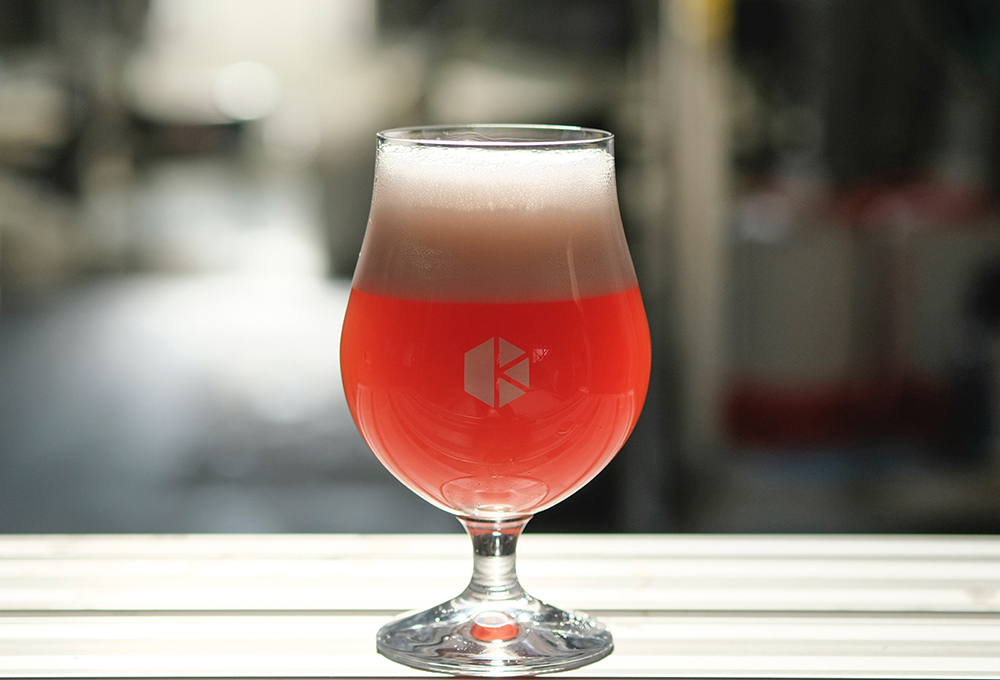
What’s with all the “sour” beers all of a sudden? Lambic and Oud Bruin have been around forever, but lately all kinds of fruited or spiced sour beers are on tap at craft beer bars everywhere. They are simpler than the Belgian classics, yet tart, refreshing, and often low in alcohol, making them great summer session beers. They often come in cans, and are much less expensive than traditional sours. It seems that Japan, too, has finally embraced the kettle sour.
Kettle souring is a relatively new innovation in the beer world. After a mash is completed, the wort is transferred to the brew kettle, but before any hop additions, it is inoculated with lactobacillus, a bacteria that ferments sugar into lactic acid. It may be a commercial culture, a wild strain, or it may be started with an addition of yogurt or whey. Within a day or two, when the wort has reached the desired level of acidity, it is boiled, which kills the bacteria, and hopped (if added at all–some kettle sours don’t employ hops). It is then fermented in whatever way the brewer chooses.
In an age where sour beers have grabbed the imagination of the craft beer world, kettle souring offers a way of making them that is cheaper, faster, and more reliable than traditional methods. Also, because the bacteria is restricted to the kettle and then killed in the boil, it cannot infect non-sour beers, making it very convenient in the brewery.
Traditional sour beers like lambic or Flemish brown and red are produced through a lengthy barrel-aging process, with various wild yeasts and bacteria slowly fermenting the beer. This produces scores of flavor compounds alongside the souring lactic acid, and results in fabulously complex beer. But it also makes such beers very expensive to make, as they require lots of storage space, often for years (see the Styles column in JBT#16 and #23 for more on other sour beers).
In contrast, kettle sours lack this complexity, unless they are later matured in barrels, as some are. For the most part, brewers use additives or dynamic dry hopping to add fruity or spicy flavors that go well with the refreshing sourness. This trend took off in 2015 in Florida, where several craft breweries became renowned for their Berliner weisse interpretations, using exotic fruits like mango, guava, passion fruit, key lime and dragon fruit, or even Japanese citrus like yuzu and sudachi.
Another traditional German beer style that has been transformed in this way is gose, which typically includes salt and coriander in the recipe. Westbrook Brewing in South Carolina produces what may be the most famous American example, a rather traditional one. Many others, including several by Anderson Valley, use fruits and spices for a more modern experience. Also look for imported kettle sours from Heretic, Stillwater, Georgetown, Avery, To Ol, and Funkwerks.
Of the few Japanese brewers who have brewed kettle sours, Ushitora and Locobeer are leading the way, the former working mainly with innovative additives, the latter with a more traditional approach. Ushitora has made an impressive line of mainly gose-based kettle sours, fruited and spiced with ingredients like ume, natsumikan, shikwasa, hibiscus, mint, yuzu, or with big dry hopping. They tend to be low alcohol, moderately sour, and big on flavor. Locobeer has produced three kettle sours. Their Yukarina Weisse is a rather traditional Berliner weisse, with soft lactic acidity and subtle wheat notes. Lichtenhainer is a traditional smoked sour wheat beer; a strange and lovely combination of flavors. Sakura Gose is salted and flavored with essence of sakura.
In addition to these, Zakkoku Kobo annually produces Berry Much, a kettle sour with homegrown yamamomo (Myrica rubra) and a variety of other berries added. It is a rich and powerful fruit and sour combination. Kyoto Brewing recently made Purple People Eater, using ume and shiso, in collaboration with Heretic. DevilCraft has also made both fruited and un-fruited versions of kettle sours. As these examples clearly show, the style offers an exciting new avenue for using traditional Japanese ingredients in beer as well.
Some barrel-aging aficionados look on the kettle sour as a cheap substitute or a trendy fake. But this is surely an over-reaction. No kettle sour is as complex and wonderful as an authentic Oude Geuze, to be sure, but there is certainly room in the craft beer universe for simple, easy-drinking sour beers featuring various interesting additives.
One might argue that with all these additives, some kettle sours turn out much more like cocktails than what we normally think of as beer–especially when you consider brave new experiments like soured New England IPAs or sweet-and-sour ice cream pale ales. Such combinations, often employing lactose for massive sweetness, are the latest thing in Scandinavia and some parts of the US, and seem meant to appeal to non-beer-drinkers. After a couple of these, you may want to reach for a pilsner. But for now, let’s enjoy watching the new directions the kettle sour trend takes in the near future.
All Beer Styles articles are written by Mark Meli, author of Craft Beer in Japan.
This article was published in Japan Beer Times # () and is among the limited content available online. Order your copy through our online shop or download the digital version from the iTunes store to access the full contents of this issue.



